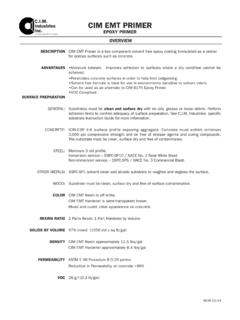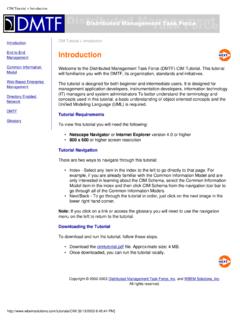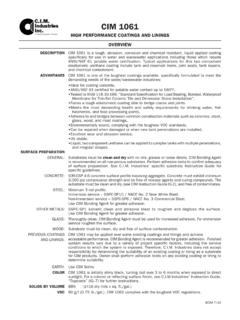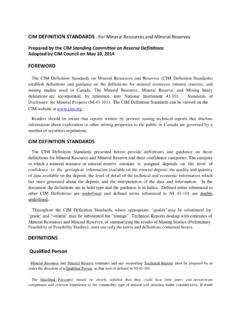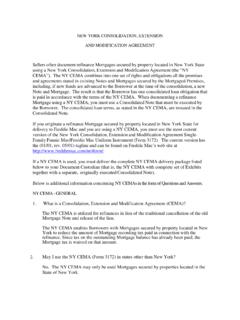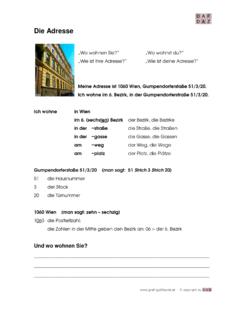Transcription of Material Safety Data Sheet - CIM Industries
1 MSDS-61TN-EPOXY-HARDENER-REV2-Feb14 1 CIM 61TN Epoxy Hardener Epoxy Primer Material Safety data Sheet CIM Industries 6900 Nelms Street Houston, TX 77061 800-543-3458 Transportation Emergency CHEMTREC: (800)424-9300 CHEMTREC International: (703)527-3887 Product Name CIM 61TN Epoxy Hardener Issue Date February 19, 2014 Supersedes Date May 31, 2013 Emergency Overview OSHA Hazards Flammable liquid, Irritant Human Effects and Symptoms of Overexposure Skin Can causes skin irritation and dermatitis. Prolonged exposure can cause severe skin burns.
2 Eye Can cause severe eye irritation, redness and blurred vision. Can cause severe irritation or burns. May cause permanent visual impairment. Ingestion Can cause irritation, vomiting, nausea and diarrhea. Can cause burns and ulceration. Inhalation May be harmful if inhaled. Vapors may cause drowsiness and dizziness. SECTION 2 HAZARD IDENTIFICATION SECTION 1 PRODUCT AND COMPANY IDENTIFICATION MSDS-61TN-EPOXY-HARDENER-REV2-Feb14 2 Hazardous Components CAS Number Material Weight % ACGIH TWA STEL 14808-60-7 Microcrystalline Silica* 30-40% mg/m3** N/E Proprietary Dimer Acids reacted with Polyamine 15-20% N/E N/E 64742-95-6 Solvent Naphtha, Light Aromatic 10-15% N/E N/E 78-93-3 Methyl Ethyl Ketone 5-10% 200 ppm 300 ppm 78-83-1 Isobutyl alcohol <5% 50 ppm N/E N/E.
3 Not Established * As supplied, this ingredient is bound in the polymer matrix. Because it is bound in the matrix, it is not expected to create any unusual hazards when handled and processed according to good manufacturing and industrial hygiene practices and the guidelines provided in this MSDS. ** As respirable dust General advice Consult a physician. Show this Safety data Sheet to the doctor in attendance. Eye Contact Rinse thoroughly with plenty of water for at least 15 minutes and consult a physician. Skin Contact Remove contaminated clothing.
4 Wash clothing before reuse. Wash off with soap and plenty of water. If skin irritation persists, consult a physician. Inhalation If breathed in, move person into fresh air. If not breathing, give artificial respiration. Consult a physician. Ingestion Do NOT induce vomiting. Never give anything by mouth to an unconscious person. Consult a physician and/or transport to a medical facility. Conditions of Flammability Material is flammable in the presence of a source of ignition. Keep away from heat, sparks, open flames and hot surfaces.
5 No smoking. Vapors may travel considerable distances to a source of ignition. Vapors are heavier than air and may accumulate in low lying areas. Suitable Extinguishing Media Use water spray, foam, dry chemical or carbon dioxide. Special Firefighting Procedures Wear self-contained breathing apparatus for firefighting if necessary. Water should be used as a fog only to keep containers cool in order to minimize pressure buildup and explosion. SECTION 3 COMPOSITION/INFORMATION ON INGREDIENTS SECTION 4 FIRST AID MEASURES SECTION 5 FIREFIGHTING MEASURES MSDS-61TN-EPOXY-HARDENER-REV2-Feb14 3 Unusual Fire/Explosion Hazard Hazardous decomposition products formed under fire conditions.
6 Personal Precautions Use personal protective equipment. Avoid breathing vapors, mist or gas. Ensure adequate ventilation. Remove all sources of ignition. Evacuate personnel to safe areas. Beware of vapors accumulating to form explosive concentrations. Vapors can accumulate in low areas. Environmental Precautions Prevent further leakage or spillage if safe to do so. Do not let product enter drains. Methods and materials for containment and cleaning up Contain spillage, apply absorbent Material and then shovel with a non-sparking tool into a closable container for disposal according to local regulations (see section 13).
7 Storage Temperature -7 C (20 F) Minimum 43 C (110 F) Maximum Storage Period Keep container tightly closed in a dry and well-ventilated place. Containers which are opened must be carefully resealed and kept upright to prevent leakage. Handling/Storage Precautions Avoid contact with skin and eyes. Avoid inhalation of vapor or mist. Use explosion-proof equipment. Keep away from sources of ignition. No smoking. Take measures to prevent the buildup of electrostatic charge. Industrial Hygiene/Ventilation Measures General local exhaust should be used as necessary to control airborne vapors and thermal decomposition products below appropriate airborne concentration standards/guidelines, especially during high heat operations.
8 Respiratory Protection Atmospheric concentrations should be maintained below the threshold limit guidelines provided. When these concentrations cannot be maintained respiratory protection is required. Use of NIOSH approved filters designed to remove a combination of particulate, gaseous and vapor materials. In confined areas use NIOSH approved positive pressure, self-contained breathing apparatus. Wear respiratory protection when sanding, grinding, blasting or cutting the cured product. Hand Protection Handle with appropriate solvent resistant gloves and pay attention to breakthrough time.
9 Gloves must be inspected prior to use. Use proper glove removal technique (without touching glove's outer surface) to avoid skin contact with this product. Dispose of contaminated gloves after use in accordance with applicable laws and good laboratory practices. Wash and dry hands. Eye Protection Chemical resistant goggles or Safety glasses with side shields should be used. SECTION 6 ACCIDENTAL RELEASE MEASURES SECTION 7 HANDLING AND STORAGE SECTION 8 EXPOSURE CONTROLS/PERSONAL PROTECTION MSDS-61TN-EPOXY-HARDENER-REV2-Feb14 4 Skin and Body Protection For brief contact no precautions other than clean body covering clothing should be needed.
10 For prolonged use impermeable gloves, clothing aprons and protective coverings should be used whenever possible. Additional Protective Measures Employees should wash their hands before eating, drinking or using tobacco products. Educate and train employees in the safe use and handling of this product. Appearance Opaque Viscous Liquid Color Light Brown Odor Solvent pH No data available Flash Point -4 C (24 F) Closed Cup Lower Explosion Limit by volume Upper Explosion Limit by volume Specific Gravity Solubility in Water Very Slightly Soluble Autoignition Temperature >450 C (>842 F) VOC <303 g/L ( lb/gal) for this component 240 g/L ( lb/gal) for the mixed epoxy (per EPA Method 24) Possibility of hazardous reactions Vapors may form explosive mixture with air.


